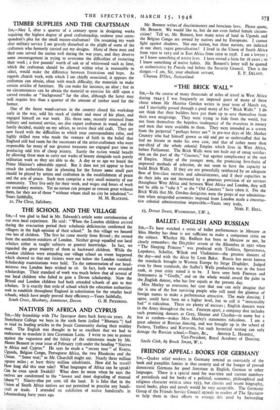BALLET : ENGLISH AND RUSSIAN
SIR,—To have watched a series of ballet performances in Moscow as Miss Morley has done is not sufficient to make a competent critic on the subject. Whether Mr. Redfern has been to Moscow or not, he clearly remembers the Diaghilev season at the Alhambra in 1921 when "The Sleeping Princess " was produced with Trefilova, Spessivtseva, Lopokova, Schollar, Wilzak and Vladimirov—the greatest dancers of the day—and with the decor by Leon Bakst. Russia has never known the standards brought to Western Europe by Serge Diaghilev. Judged even by those standards, the Sadler's Wells production was in the front rank, as your critic stated it to be. I have seen both Fonteyn and Semyonova in " Giselle," and on the whole would award the palm to the ,English dancer, who has few equals at the present day. Miss Morley so overstates her case that one can only imagine that she is one of the few surviving people who still need the glamour of foreign names to make a performance attractive. The male dancing; I agree, could have been on a higher level, but to call it " inexcusably bad " is ridiculous. There are plenty of excuses ; English dancers were in the Army throughout the war. Fonteyn apart, a company that includes such promising dancers as Grey, Shearer and Clayden—to name but a few at random—makes Miss Morley's statements ridiculous. I am a great admirer of Russian dancing, and was brought up in the school of Pavlova, Trefilova and Karsavina, but such hysterical writing can only damage the Russian school.—Yours, &c., ARNOLD L. HASKELL, Vice-President, Royal Academy of Dancing. Savile Club, 69 Brook Street, W. r.


























 Previous page
Previous page